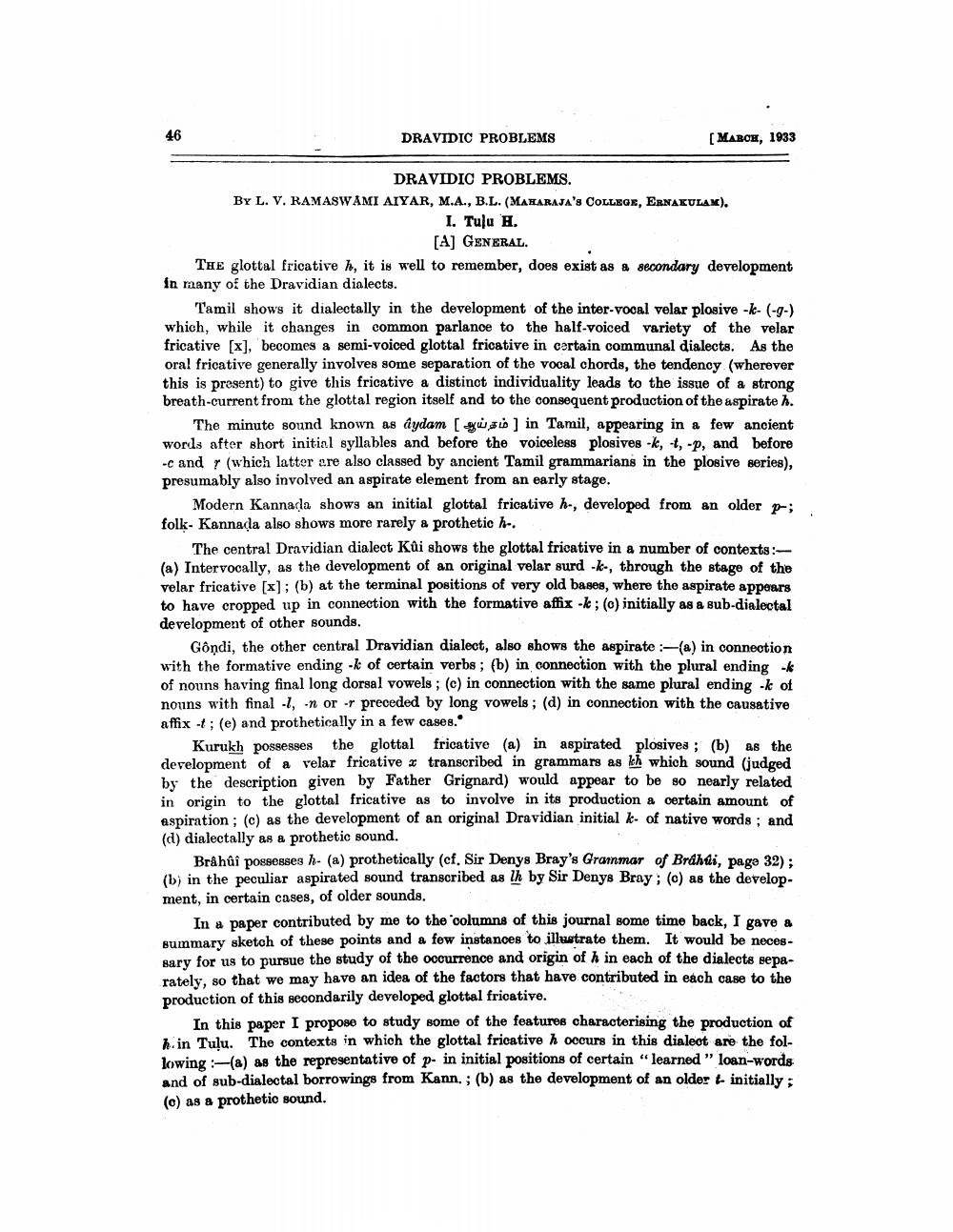________________
DRAVIDIC PROBLEMS
[MABOH, 1933
DRAVIDIO PROBLEMS. BY L. V. RAMASWAMI AIYAR, M.A., B.L. (MAHARAJA'S COLLEGE, ERNAKULAM).
I. Tuļu H.
[A] GENERAL The glottal fricative h, it is well to remember, does exist as a secondary development in many of the Dravidian dialects.
Tamil shows it dialectally in the development of the inter-vocal velar plosive -- (-9-) which, while it changes in common parlance to the half-voiced variety of the velar fricative [x], becomes a semi-voiced glottal fricative in certain communal dialects. As the oral fricative generally involves some separation of the vocal chords, the tendency (wherever this is present) to give this fricative a distinct individuality leads to the issue of a strong breath-current from the glottal region itself and to the consequent production of the aspirate h.
The minute sound known as dydam [w ] in Tamil, appearing in a few ancient words after short initial syllables and before the voiceless plosives -k, t, -p, and before -c and r (which latter ere also classed by ancient Tamil grammarians in the plosive series), presumably also involved an aspirate element from an early stage.
Modern Kannada shows an initial glottal fricative h-, developed from an older p-; folk- Kannada also shows more rarely a prothetic h-.
The central Dravidian dialect Kui shows the glottal fricative in a number of contexts:(a) Intervocally, as the development of an original velar surd-k., through the stage of the velar fricative [x]; (b) at the terminal positions of very old bases, where the aspirate appears to have cropped up in connection with the formative affix-k; (c) initially as a sub-dialectal development of other sounds.
Gôndi, the other central Dravidian dialect, also shows the aspirate : a) in connection with the formative ending - k of certain verbs; (b) in connection with the plural ending - of nouns having final long dorsal vowels; (c) in connection with the same plural ending - k of nouns with final -2, -n or -r preceded by long vowels; (d) in connection with the causative affix -+; (e) and prothetically in a few cases.
Kurukh possesses the glottal fricative (a) in aspirated plosives ; (b) as the development of a velar fricative x transcribed in grammars as kh which sound (judged by the description given by Father Grignard) would appear to be so nearly related in origin to the glottal fricative as to involve in its production a certain amount of aspiration ; (c) as the development of an original Dravidian initial k- of native words; and (d) dialectally as a prothetic sound.
Bråhûi possesses - (a) prothetically (cf. Sir Denys Bray's Grammar of Brahdi, page 32); (b) in the peculiar aspirated sound transcribed as lh by Sir Denys Bray; (o) as the development, in certain cases, of older sounds.
In a paper contributed by me to the columns of this journal some time back, I gave a Bummary sketch of these points and a few instances to illustrate them. It would be necessary for us to pursue the study of the occurrence and origin of h in each of the dialects separately, so that we may have an idea of the factors that have contributed in each case to the production of this secondarily developed glottal fricative.
In this paper I propose to study some of the features characterising the production of hiin Tulu. The contexts in which the glottal fricative h occurs in this dialeot are the following :-(a) as the representative of p- in initial positions of certain "learned " loan-words and of sub-dialectal borrowings from Kann. ; (b) as the development of an older - initially; (c) as a prothetic sound.




